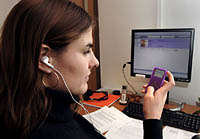Inside Iowa State
Inside ArchivesSubmit newsSend news for Inside to inside@iastate.edu, or call (515) 294-7065. See publication dates, deadlines. About InsideInside Iowa State, a newspaper for faculty and staff, is published by the Office of University Relations. |
Dec. 09, 2005 Iowa State catches the podcasting waveby Samantha Beres When iTunes came around, it caught on fast. It seemed like suddenly (to some of us) everyone was walking around with little white earplugs dangling from their ears. But mp3 players and visits to iTunes aren't just about music anymore. 
Student Lori Lynch listens to a podcast she has downloaded to her iPod. She works with Julio Rodriguez to produce podcasts to promote the foreign languages department. Photo by Bob Elbert A new technology that is becoming popular ever so quickly is podcasting, a new way to distribute audio and video programming over the Internet. Users subscribe to programs, most of which are free. The beauty lies in the convenience. The programs automatically download onto the subscriber's computer as they become available. Users can watch or listen to them whenever they want from a computer, or for the technologically up-to-date, from small handheld mp3 players, such as an Apple iPod. There are lots of podcasts to choose from -- radio shows, TV shows, lectures, poetry, books. One guy set up a camera in his car and does a podcast of his ride to work everyday. So, the intentions in producing podcasts can vary. Podcasting from Iowa StateExtension uses the new technology to better serve Iowa communities. Last summer, a farmer asked ISU Extension communications manager Elaine Edwards about WOI Radio's weather call-in show. He depends on the show, but when it broadcasts, he's out working. Could he hear it without having to tune in to the radio? Sure, she replied. He could listen to the podcast. Extension certainly has caught the podcasting wave. The Market News Report, Midday and interviews with Extension specialists that broadcast on WOI Radio are available as podcasts. Also, Gardening in the Zone, two-minute video segments that offer gardening tips, are produced as video podcasts or "vodcasts," a term coined because the word "podcast" means audio files to many people. "It's another format that allows us to get information out there and into the hands of many," Edwards said. "Anybody, anywhere can go to the Apple iTunes store and type in 'Iowa State' and find out what we have available in the podcast format," Edwards said. She added that the possibilities for this technology are endless. Julio Rodriguez saw the possibilities in using podcasting to recruit students to the foreign languages department. Rodriguez, director of the Foreign Languages Learning Resource Center, and a group of undergraduate students currently work on the project, "LangCasts: Experiencing Languages Through ISU Podcasts." The project is a series of 20 podcasts called Doors to a world of adventures . . . Each audio file is about 12 minutes long. Ten will focus on the department's academic programs and 10 will be mini language lessons. The idea is to let students experience first-hand the languages offered by the department. "I'm interested in the medium because it's so natural for language learning. It's so accessible," said Rodriguez, who sees a bright future for podcasts in language learning classes. "This is going to have an impact on education, for sure," he said. Podcasts as an education toolPodcasting already has had an impact on education. For one, it has broadened the availability of educational material. More than a dozen Iowa State faculty from the English department have lectures available as podcasts. Associate English professor Geoffrey Sauer set up a studio in Ross Hall to facilitate production of these podcasts. "It's in our interest to produce visible, public represen-tations of what we do well," he said. It's too early to decipher a trend in how educators and students use podcast lectures because as Sauer pointed out, "We're in a period where everything is changing." But certainly, a student could use available lectures as study tools, supplementary material or to catch a missed lecture. Podcasting has become a necessary element of the curriculum in distance learning. This fall, 15 distance learning engineering classes became available as podcasts. Joe Monahan, information and communication technologies specialist for Engineering distance education, created a tablet system for distance education that he uses to create the videos that are podcast. These systems capture a video of the professor's computer screen, including any equations or diagrams the professor may create in class -- he or she writes directly on the screen rather than on a whiteboard. Since these courses also are attended by students on campus, the podcasts for them can provide an additional learning tool. Of course, there are the students who might skip class because they know they can view the video later, said Monahan, but he asks, "Would these students have skipped the class anyway? The podcasts in that case can provide a safety net." Right now, the distance education podcasts are available in a format that plays best on computers. Next semester, Monahan plans to create podcasts in a format better suited to playback on handheld portable devices like cell phones or iPods. "I predict that the demand (for podcasted content) is simply going to be there," said Monahan. "It's just too easy and it makes too much sense." |
Try one outYou can find some podcasts mentioned in this story by searching for "Iowa State University" using iTunes or through these sites: Read about lecture podcasts. |